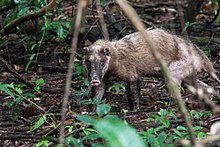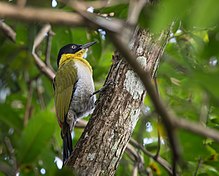Huai Kha Khaeng Wildlife Sanctuary
| Huai Kha Khaeng Wildlife Sanctuary | ||
|---|---|---|
| Huai Kha Khaeng | ||
|
|
||
| Location: | Kanchanaburi , Thailand | |
| Surface: | 2574 km² | |
| Founding: | 1972 | |
The Huai Kha Khaeng Game Reserve ( Thai : เขต รักษา พันธุ์ สัตว์ ป่า ห้วย ขา แข้ง , pronunciation: [ k : èʰt ráksǎː pǎːan sàt pàː hûaj kʰǎː kʰɛ̂ng ]) is a game reserve in the provinces ( Changwat ) of Kanchanaburi , Tak and Uthai Thani in northern Thailand . It was added to the UNESCO World Heritage List in 1991 . The sanctuary, along with adjacent areas such as Thung Yai , is home to the world's largest population of the endangered Indochinese tiger . It is also one of the most important refuges for numerous other threatened large animal species. Including Asian elephants, clouded leopards , water buffalo, bantengs , gaure and saddleback tapirs .
location
The Huai Kha Khaeng Wildlife Sanctuary is located in the Tenasserim Mountains on the western border between Thailand and Myanmar , at the southern end of the Dao Na mountain range .
With the adjoining, but separately managed, wildlife sanctuary Thung Yai Naresuan , it is one of the largest protected areas in Southeast Asia. Together with other protected areas, the two reserves form the Western Forest Complex , the largest contiguous protected area on the Southeast Asian mainland.
topography
The designated area of the wildlife reserve is 257,464 hectares after it was expanded in 1986.
The terrain is generally hilly and has year-round and seasonal waters. The height ranges from 250 meters to 1678 meters.
fauna and Flora





The game reserve is mainly covered with forests, the mountain slopes have evergreen rainforest or evergreen dry forest . In the wetlands and along the watercourses there is also evergreen gallery forest with numerous species of climbing plants and epiphytes . The wing fruit plants , which are rare in Southeast Asia , can also be found here.
The size of the wildlife sanctuary, which merges into the neighboring areas of Thung Yai Naresuan and the Umphang wildlife sanctuary , means that a number of larger mammal species, which have rarely or completely disappeared in the rest of Thailand, still occur here. The endangered species in the reserve include the Indochinese tiger , the largest population in the world in the national park complex. About 154 tigers live here and in the surrounding protected areas. Other threatened species are leopards (the black form is about as common here as the spotted one), clouded leopards , Asian wild dogs , black- backed tapirs , Asian elephants (around 150–200 animals), Gaure , Bantengs , Tenasserim muntjacs , pig deer (rare) and the Sumatra Serau . In addition, there are around 24-40 wild water buffalo , the only population in Thailand. However, there are doubts about the purebredness of these animals as they may have mixed with domestic water buffalo. The occurrence of the Siamese lyre deer has been unconfirmed since 1965 , when two of these animals were shot. The Sumatran rhinoceros , which is no longer found in Thailand today, is also extinct .
At least two species of otters have been identified, the dwarf otter and the soft-fur otter . In the reserve all five occurring in Thailand find Makakenarten , the rhesus macaque , the cynomolgus monkey , the Northern Pig- who Assam Macaque and the stump-tailed macaque . Other species of monkey in the area include silver crested langurs , Phayre's long-tailed langurs and white-handed gibbons .
Numerous bird species have been identified so far, including rare species such as the eared peacock , the bald-headed vulture and the Kalij pheasant . The stately Bengal monitor deserves a special mention among the reptiles .
In total, the UNESCO report lists 120 mammal, 400 bird, 96 reptile, 43 amphibian and 113 freshwater fish species.
climate
The climate is tropical - monsoonal to semi-tropical . The rainy season begins in May or June and lasts until October. Afterwards it is dry and relatively cool, only to get very hot in March to May.
The average annual rainfall in the west is 2000 to 2400 mm, in the east somewhat less (1600 to 2000 mm). About 80% of the annual rainfall is brought about by the pronounced southwest monsoons.
The average temperatures are:
Jahreszeit Minimum Maximum Regenzeit 20 °C 33 °C kühl 10 °C 29 °C heiß 15 °C 35 °C
The absolute temperatures are between 7 and 40 ° C.
history
Huai Kha Khaeng was designated as a wildlife sanctuary on August 26, 1972 together with the neighboring Thung Yai Naresuan . In 1991 it was entered in the list of the world's natural heritage .
According to sporadic finds, the area has been inhabited since the Pleistocene , but detailed research is still pending. Today some members of the hill tribes of Thailand (here Hmong and Karen ) live here , most of them have already been resettled in the province of Tak.
Individual evidence
- ↑ UNEP: THUNGYAI - HUAI KHA KHAENG WILDLIFE SANCTUARIES THAILAND ( page no longer available , search in web archives ) Info: The link was automatically marked as defective. Please check the link according to the instructions and then remove this notice. (PDF; 147 kB)
- ↑ Panthera tigris ssp. corbetti in the IUCN Red List of Threatened Species 2010.4. Posted by: Lynam, AJ & Nowell, K., 2010. Retrieved December 3, 2012.
- ↑ Dicerorhinus sumatrensis in the endangered Red List species the IUCN 2008. Posted by: van Strien, NJ, Manullang, B., Sectionov, Isnan, W., Khan, MKM, Sumardja, E., Ellis, S., Han, KH , Boeadi, Payne, J. & Bradley Martin, E., 1996. Retrieved May 29, 2012.
Web links
- http://www.unep-wcmc.org/sites/wh/huaikk.html Description of UNEP in English [accessed on April 23, 2007]
- http://www.sefut.uni-freiburg.de/buergin.htm Detailed description of the mountain peoples and their influence on the environment [accessed on April 23, 2007]
- Entry on the UNESCO World Heritage Center website ( English and French ).



